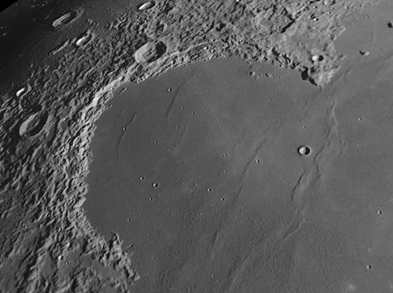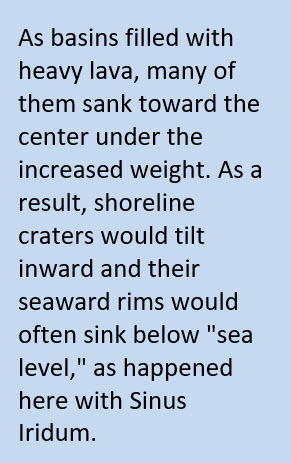The week of February 5-11 takes us from Day 25 to Day 2. This week we will highlight Sinus Iridum, viewable on Tuesday.
 Sinus Iridum: [NW/E6; L=32°W] Sinus Iridum (the Bay of Rainbows), located in the northwest sector of Mare Imbrium, formed after the Imbrium impact but before the lava flooding that filled the Imbrium basin. This bay is itself an enormous 160-mile moon crater and is the largest and most spectacular example of subsidence on the Moon. If you have very sharp eyes, without optical aid you should be able to see the “bite” that Iridum takes out of Mare Imbrium.
Sinus Iridum: [NW/E6; L=32°W] Sinus Iridum (the Bay of Rainbows), located in the northwest sector of Mare Imbrium, formed after the Imbrium impact but before the lava flooding that filled the Imbrium basin. This bay is itself an enormous 160-mile moon crater and is the largest and most spectacular example of subsidence on the Moon. If you have very sharp eyes, without optical aid you should be able to see the “bite” that Iridum takes out of Mare Imbrium.
When the Sun is at a low angle, you can see that Sinus Iridum is covered with wrinkle ridges like so many waves lapping toward the shore.
 The mountains on the rim of the bay have their own name, the Jura Mountains. This wall of mountains curves protectively around the bay and descends, because of the above-mentioned subsidence, to sea level where they terminate in capes at each end: Promontorium Laplace† on the northeast and Promontorium Heraclides on the southwest.
The mountains on the rim of the bay have their own name, the Jura Mountains. This wall of mountains curves protectively around the bay and descends, because of the above-mentioned subsidence, to sea level where they terminate in capes at each end: Promontorium Laplace† on the northeast and Promontorium Heraclides on the southwest.
Pay close attention to Promontorium Heraclides. Under the right lighting conditions around Day 10 you can see the profile of a woman’s head with long flowing hair. Those who have gotten to know her refer to her fondly as the Moon Maiden. Cassini himself was the first person to describe this feature. She reveals herself best when the seeing is a bit “soft” and the terminator has just cleared the western edge of the Jura Mountains. At this time, you will see her gazing across the bay to Promontorium Laplace, her hair streaming out behind her. If the seeing is crisp, try defocusing a little.
OF ADDITIONAL INTEREST IN SPACE
On Wednesday, Venus is 5° north of the Moon, and on Thursday, Mars is 4° north of the Moon. New Moon is on Friday.
======================
It is highly recommended that you get a copy of Sky and Telescope’s Field Map of the Moon, the very finest Moon map available for use at the telescope. It is available for $10.95 at www.skyandtelescope.com and on Amazon. All features mentioned in this blog will be keyed to the grid on the Field Map and will look like this: Plato: [NW/D9]
Credits:
Courtesy of Gray Photography of Corpus Christi, Texas
Lunar photos: NASA / USGS / BMDO / LROC / ASU / DLR / LOLA / Moon Globe. Used by permission
- Rupes Cauchy: A Best Known Fault on the Moon - July 22, 2024
- Moon Crater Schickard – Crater Floor has Stripes - July 15, 2024
- Moon Craters Langrenus and Vandelinus - July 8, 2024